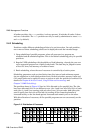
2
Overview of RMS
2.1 Introduction
This chapter describes the role of the Resource Management System (RMS). The RMS
provides tools for the management and use of a Compaq AlphaServer SC system. To put
into context the functions that RMS performs, a brief overview of the system architecture
is given first in Section 2.2. Section 2.3 outlines the main functions of the RMS and
introduces the major components of the RMS: a set of UNIX daemons, a suite of
command line utilities and a SQL database. Finally, Section 2.4 describes the resource
management facilities from the system administrator’s point of view.
2.2 The System Architecture
An RMS system looks like a standard UNIX system: it has the familiar command shells,
editors, compilers, linkers and libraries; it runs the same applications. The RMS system
differs from the conventional UNIX one in that it can run parallel applications as well as
sequential ones. The processes that execute on the system, particularly the parallel
programs, are controlled by the RMS.
2.2.1 Nodes
An RMS system comprises a network of computers (referred to as nodes) as shown in
Figure 2.1
. Each node may have single or multiple processors (such as a SMP server);
each node runs a single copy of UNIX. Nodes used interactively to login to the RMS
Overview of RMS 2-1


















